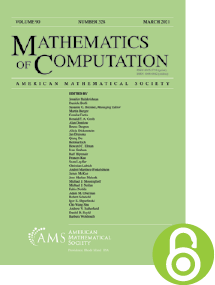Some numerical evidence concerning the uniqueness of the Markov numbers
HTML articles powered by AMS MathViewer
- by D. Rosen and G. S. Patterson PDF
- Math. Comp. 25 (1971), 919-921 Request permission
Abstract:
A Markov triple is a set of three positive integers satisfying the diophantine equation $({x^2} + {y^2} + {z^2} = 3xyz)$. The maximum of the triple is called a Markov number. Although all Markov triples can be generated from the triple (1,1,1), it is not known whether it is possible to obtain $(p,{a_1},{b_1})$ and $(p,{a_2},{b_2})$, where p is the same Markov number for both triples. All Markov numbers not exceeding 30 digits were computed without turning up a duplication, lending some credence to the conjecture that the Markov numbers are unique.References
- J. W. S. Cassels, An introduction to Diophantine approximation, Cambridge Tracts in Mathematics and Mathematical Physics, No. 45, Cambridge University Press, New York, 1957. MR 0087708 L. E. Dickson, Studies in the Theory of Numbers, Univ. of Chicago Press, Chicago, Ill., 1930. G. Frobenius, “Über die Markoffschen Zahlen,” S.-B. Preuss. Akad. Wiss., v. 1913, pp. 458-487.
- Donald E. Knuth, The art of computer programming, 2nd ed., Addison-Wesley Series in Computer Science and Information Processing, Addison-Wesley Publishing Co., Reading, Mass.-London-Amsterdam, 1975. Volume 1: Fundamental algorithms. MR 0378456 A. Markoff, “Sur les formes quadratiques binaires indefinées,” Math. Ann., v. 15, 1879, pp. 381-409.
Additional Information
- © Copyright 1971 American Mathematical Society
- Journal: Math. Comp. 25 (1971), 919-921
- MSC: Primary 10B10
- DOI: https://doi.org/10.1090/S0025-5718-1971-0300972-X
- MathSciNet review: 0300972


